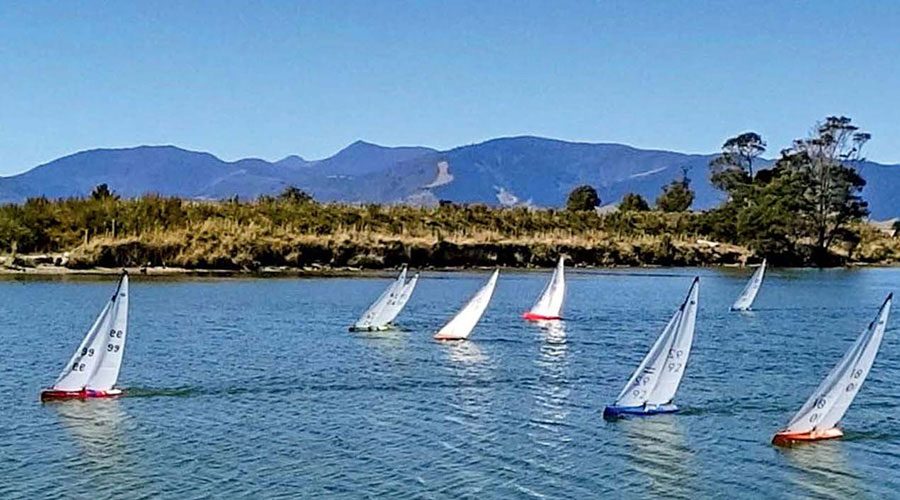

Continuing our series on the yacht clubs of New Zealand, we thought we’d visit a couple in each island with the easiest access to an introduction to sailing.
Here’s how to go sailing, no worries, without getting your feet wet. No HR issues either with finding and retaining crew. And all for a lot less outlay than a boat and a mooring or a trailer or new marina berth. And, probably, more bang for your buck by way of uncomplicated fun.
Welcome to the world of radio-controlled yachting, via the Waiheke Island Radio Yacht Club or Nelson Radio Sailing Club Inc – the newest and perhaps the oldest clubs for radio-controlled yachts in the country.
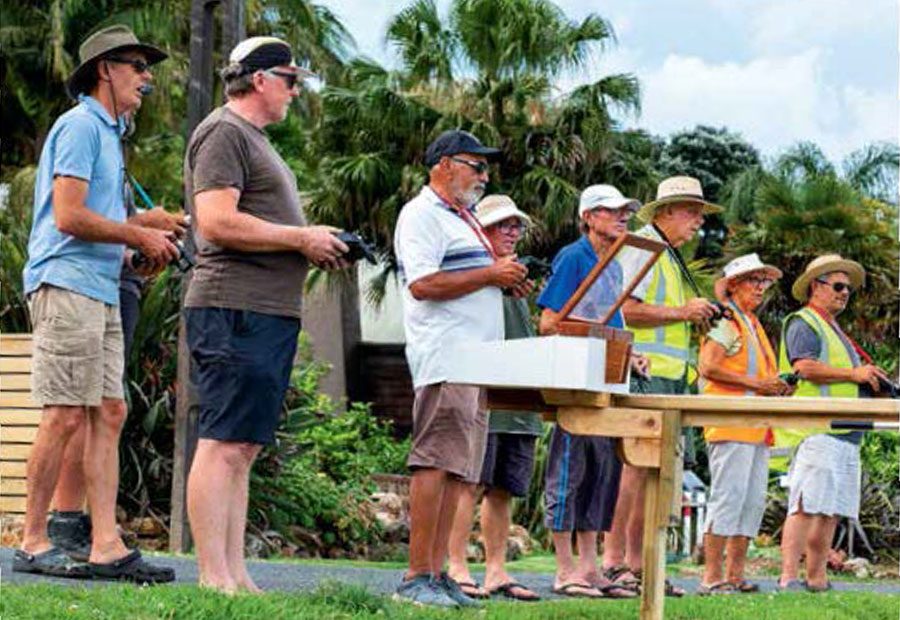
Here’s how to get into it.
STEP ONE: Mosey on down to their patches of sailing water, to chat with the yacht racers and to see if steering one of these slim sailing machines rings your bells. The skippers will be happy to talk while piloting their craft. Only don’t expect eye contact. That’s reserved exclusively for the diminutive sailboats out there.
STEP TWO: Buy a DragonForce 65 one-design model yacht. They are surprisingly cheap; only a coupla hundred bucks, and come complete with the radio, a display stand, and options for three rigs of differing mast height and sail area. There are other, often more complicated, classes of radio-control yachts – but these DragonForces appear to be the best/easiest place to start
STEP THREE: Personalise your boat with dazzle paint or groovy graphics, all the better to identify it in the fleet from a distance. Maybe fit an oversize burgee too.
STEP FOUR: Get sailing! Do a few private trial runs to avoid beginner bungles. Then enter the races. Though at first, you may be in the starters’ fleet. For among the model yacht sailors at every New Zealand club are some very experienced, very fast, big boat racing helms. These folk know their stuff!
Like Richard Potter, long-time giant-killer in the Waiheke Boating Club’s full-size fleet, aboard his radical converted Pied Piper Beep Beep. Or Dave Humpherson, a savvy, technical sailor of all boats from Jollyboats upwards, and a gifted amateur yacht designer too. Or Ross Barnett, he of trimaran cruising and kayak adventuring fame.
At Nelson a competitor in both the IOM class and DF65 class is gracious grandmother Linley Morten, née Atkinson. She’s yachting royalty, being the daughter of Keith Atkinson who built winning M Class boats along with Laurie Davidson, and a winning big-boat helm herself. Or her partner Peter Foster, long-time campaigner of an Alan Wright-designed Quarter Tonner. Or Bob Spearman, 92 years young – there’s experience for you! Other notable big and small boats sailors at Nelson include Basil Hart, Kendal Allcott, John Levy and Peter Jensen.
Expect to be humbled on the race course.
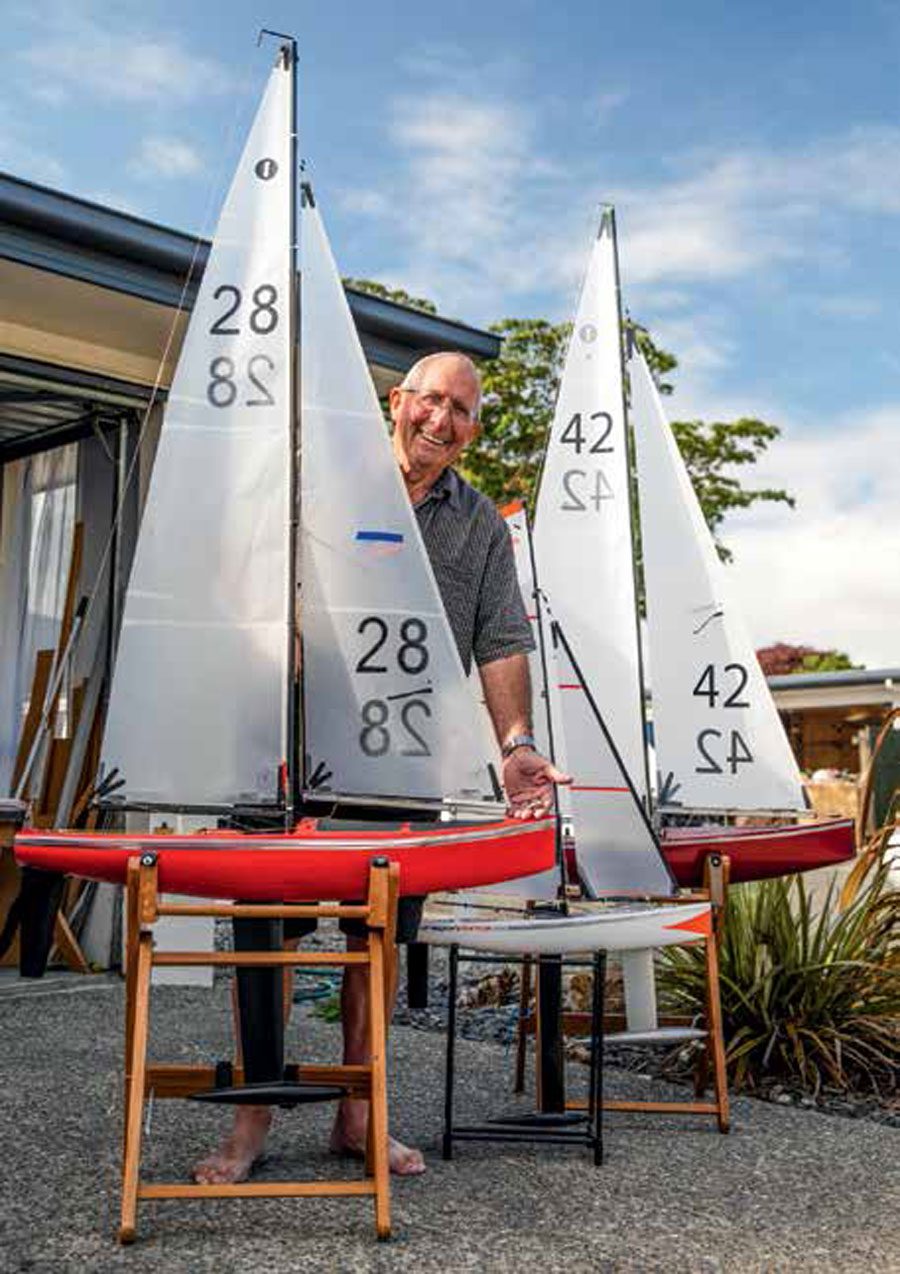
STEP FIVE APPEARS A GIVEN: You’ll get hooked!
DRAGONFORCE 65
These yachts are small works of naval architecture art. They are quite beautiful. And radical too. If a DragonForce 65 were a 30-foot keelboat say, its draft would be… about 20 feet!
Despite its extreme draft and bulb keel, your Dragon Force 65 will heel alarmingly in responding to gusts on the water. On a real yacht this would have the crew sliding off the deck and into the water like hapless lemmings. But you’re firmly based on dry land so you can drive the boat as hard as you like, heeling be damned! The narrow hull of the DragonFroce 65 is obviously very easily-driven.
Waiheke’s Radio Yacht Club fleet is the newest addition to those of the 14 clubs affiliated to the New Zealand Radio Yachting Association. Nelson Club has been around for almost 30 years and membership has doubled in the last year.
Waiheke’s club was established in 2019 by Glenn Fowler, an experienced yachtie from way back. He initially bought a second-hand boat on Trade Me, but soon found “like everything in life, it was not a lot of fun on my own.”
So he bought another model boat, and invited a mate to join him. Then another old salt saw them at the Causeway, and also bought two boats – one for his wife. And the club was away from there.
It has rocketed to prominence, now being one of the most active clubs with among the biggest racing fleets in the country (the club’s Facebook group has 93 members!). Though, in the researching of this story, the good folk in Nelson contacted me to remind us that, hey, they have big racing fleets there too – and of different classes. On our summer circumnavigation of New Zealand, we popped in to visit.
This connection with other clubs means that model yacht sailors can enter regional and national championships, and even international regattas.
As the blurb has it, “The DragonForce 65 is one of the fastest growing classes of radio-controlled yachts worldwide… it is the boat for those who want an excellent performance boat at a fraction of the cost of other boats.”
Glenn fills me in with the detail of what you buy: “I sell at cost, $450 with a basic radio transmitter/receiver, and $550 with an upgraded trans/rec. Additional rigs complete with sails – $150 A+. Boat comes with A set, B rig and C rig.”
Linley reminds me that very fine second-hand boats can be found on Trade Me. In fact, her current race-winning yacht – a Frank Russell Ellipsis – was one of those. She also has the advantage of Peter working tirelessly to keep their boats ship-shape. He also does fine videos of the racing – Google them on Youtube. His Yacht Renovations During Lockdown has had over 9,000 views! https://youtu. be/32KC1JHr3z8
The copy on the DragonForce 65 website then gets a bit technical: “The new version 6 now comes with 50 micron Mylar film sails with a clean new style… the digital rudder servo has been given a 10% boost in torque and improved electronics.”
The mast of the DragonForce 65 is free-standing, but it does have a single backstay, adjustable to set up a bend in the mast to de-power the mainsail if required – a before-the-race tweaking made on shore.
While sailing, the controls at your fingertips are in-out on the mainsail and jib sheets, and steering via the rudder arm.
There’s one tiny wee piece of fine print: “Not recommended for use in salt water.” Richard Potter tells me cleaning up the boat after a session on the briny becomes a much-loved ritual.
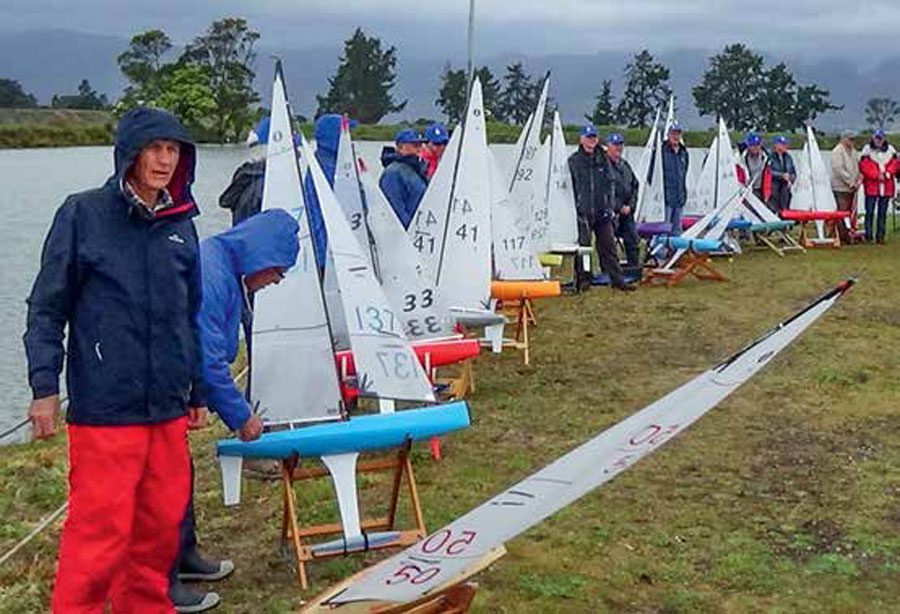
OTHER CLASSES
The New Zealand Radio Controlled Yachts Association races halfa-dozen different classes. The most popular has been the IOM (International One Metre), which is raced in over 30 countries. The hull cannot exceed one metre in length and the complete boat ready to sail must exceed 4kg. Two-channel radio equipment is required; one operates the winch, the other the rudder. The class was created in 1988 by Jan Dejmo, aided by Graham Bantock and the Technical Committee of the IMYRU (predecessor of IRSA).
Then there’s the RM International Marblehead. The modern ‘M’ class yacht is the high-tech option for radio-control sailors. The Marblehead class rules allow for up to six measured rigs, and plenty of additional room for individual boat experimentation, including profiled rotating masts, unstayed carbon rigs, pocket luff mainsails, pre-preg carbon hulls and fins, offering a wide scope for design freedom. These boats are 129cm overall length, and I read that “the restricted development class rules allow both the professional [there must be people who fit this appellation!] or amateur designers/builders/sailmakers an attractive avenue to test their knowledge and skills.”
And the Canterbury J Class which allows handy newcomers to the sport to get started quickly with a good handling model yacht that is easy to build and cost effective. I learn that 270 hulls have been sold and they are found throughout New Zealand, and some as far afield as the USA, Canada and the UK. It is a one-design yacht and all hulls come from official moulds approved by the Canterbury J Association, each with an identification number stamped into the hull.
Plus the bigger sister of the DragonForce 65, the DragonFlite 95 (DF95), noted for its light weight and long, narrow hull, which gives it outstanding light airs performance. The DragonFlite 95 approaches strong wind with alternative lower-aspect rigs. The sales clincher: “Even when the boat is overpowered it still remains easily controllable to windward and always has astonishing speed downwind with almost no tendency to nosedive.”
To make a statement on the water, there’s the East Coast 12 Metre, which at 1.5m in length and with a mast standing 1.8m above the deck, is a very impressive radio-controlled yacht.
The EC12 originated in the USA and eventually made its way to New Zealand in the 1980s, slowly but steadily growing from small beginnings to the class it is today, with more than 160 built, the majority within the last 20 years.
Just like their full-size inspirations, the old America’s Cup 12 Metre yachts, the EC12s carry a certain cachet – and a bunch of rules.
“All hulls are produced from the International One Design mould. New hulls must be purchased through the Owners Association which in turn passes this building instruction on to the Class-approved boat builder who will communicate with the prospective owner discussing as to what level of completion they wish. All boats when finished will be measured by the Class Measurer to ensure compliance with the all-important Class Rule. This ensures compliance to the principal of a one design class where all boats irrespective of age will remain competitive.”
And the class that looks quite charming to me, the ¼ Scale Zephyr, which replicates the legendary Des Townson’s also legendary dinghy design. It would appear these are for more traditional aficionados of boatbuilding.
All model hulls come from the same mould with the concept of continuing with the Des Townson wooden construction principles using light plywood and small timber stringers and keeping with the tradition of varnish work. “Moulds have been completed for a full hull and deck in fibreglass, as the full-size boat has. The idea of taking a scale model of a full size dinghy and making that into a radio-controlled keelboat took a considerable amount of research and development to arrive at what we have today.”
I reckon! But knowing Townson’s talent for drawing lovely boats, I imagine the model works well too.
“All the current owners are either current or past skippers of the full-size Zephyr who not only have a passion for the class but also a love of sailing the ¼ Scale without getting wet or crippled.” Enough said.
The fine website of the Radio-Controlled Yachts Association features some photos of interesting-looking multihulls. But no mention of a distinct class of these just yet.
Chris Heyward at Nelson has a radio-controlled model foiling cat. Top that!
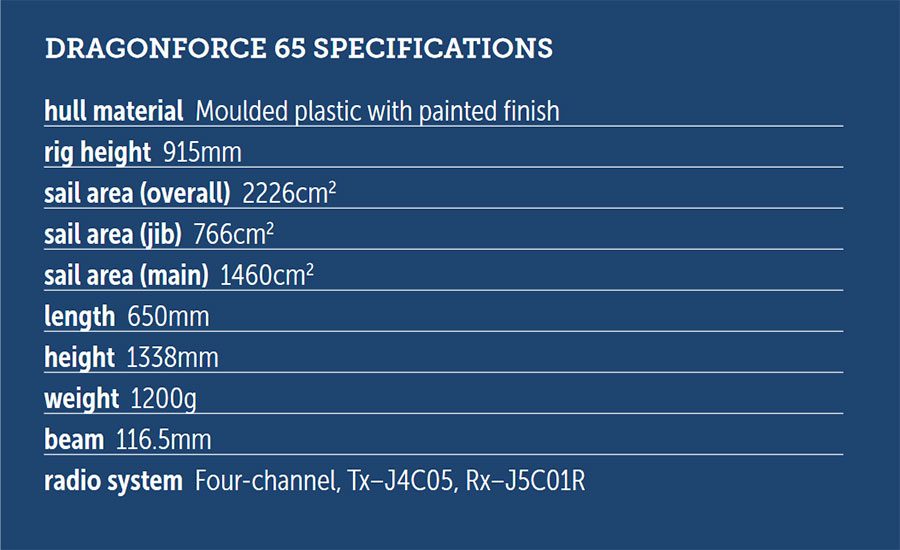
STANDARD RACING RULES
Yes, some of the Waiheke radio yacht sailors do have other models, but all their fleet racing is done with the DragonForce 65s. Nelson, by contrast, has a much more diverse fleet.
The DragonForce 65 is a strict one-design racing class, so you’re sailing against equal boats in every respect. Some accessories are allowed in the class rules, and it is possible to see boats with different rigs in the same race, as skippers may have opted for alternative sail plans depending on what they expected the breeze to do. The one-design ethos still applies, regardless of what rig you’ve chosen. No handicaps. First across the line is the winner.
All the standard yacht racing rules apply. Though when Lesley and I were photographing the boats in action, we noticed there didn’t appear to be any penalties for touching a mark on the course. Perhaps this is overlooked given the difficulties with long-distance vision and parallax in knowing exactly where your boat really is. Or even telling whether you really did brush the buoy.
Mostly, we observed fairly generous room given to mark roundings, and boats crossing tacks. Also, from our vantage on the water in our rubber dinghy, we noticed that the small yachts, though able to point really high into the wind, made tacks through unexpectedly wide angles – again, possibly a result of skippers playing safe given the longdistance view. Getting into irons is an embarrassment, no matter what size your sailboat, eh!
I also had the random thought about what the protocols are with regard to bumping into, or literally stepping on the toes of a fellow skipper. I know that would be a possibility with me – so fixated I’d be on controlling my yacht at a remove.
We noticed a variety of burgees, pennants and telltales to help guide the shore-based helmsperson (men and women the day we were there at Waiheke, including the competing couple Dot and Mike Hilburn) to figure out apparent wind on a boat from afar. I know this would be the biggest challenge for short-sighted ol’ me. On the dead downwind legs, the boats’ jibs naturally fly out goose-winged all by themselves, so this would be a help in understanding that wind direction.
But here I am applying thoughts from traditional, fullsize yachting to a whole new arena of this multi-faceted sport. Best I shut up right now, and just accept there are new adventures of learning to be had on the banks of radio-controlled yachting waters.
Just like the good folk of the Waiheke Island Radio Yacht Club, the Nelson Radio Yachts, and all the other New Zealand clubs do. Good on them! BNZ




